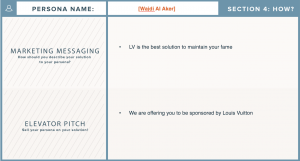Nowadays, luxurious firms for clothes use the basic methods of marketing, which are typical clothes websites, and phone applications. In addition, there are some features which add value to their marketing methods. However, luxurious firms have not been using any innovative ways in order to marketize their products.
The newly proposed idea is a clothing avatar. Initially, the idea can be implemented on websites and phone applications.
The first version is that whenever the customer gets into the website or the app, then, five clothed avatars come up on the screen. After that, the customer picks one of them, and it displays other outfits and related clothes based on the chosen avatar out of them.
The critique of this scenario is that the avatars might not cover a certain customer’s taste. specifically, when the customer is from the age of 18-24 because they have a very difficult taste of clothes. On the other side, the customer might like more than one outfit. Then, the customer gets forced to return to the original kind of browsing on the website. Which then, disables the added value of the avatars in this type of marketing.
The second version, in this scenario the customer can implement their own taste of clothes. When the customer gets into the website or the app, an unclothed avatar comes up. Then, the customer begins dressing the avatar up. Thus, when the customer is done dressing, the avatar gets submitted, and the customers get a few choices which might be related to their taste of clothes.
This method can be applied to the websites and applications by simple processes of IT and graphical designs to create the avatars and make them look real. However, according to Zax (2011), this method can be defined as an illegal concept. Because, when the customer enters the website, an unclothed avatar comes up. Thus, some of the customers considered it as a semi-nudes. Therefore, some of the customers that are under 18 might deal with it in the wrong way by rotating the avatar to look at its body (abandoned areas). In addition, it may drive the immature customers for sexual harassments to feed their sexual desire.
The third version, this scenario integrates more with the customer’s privacy. The customers have to take a photo for themselves as a full body photo, not necessarily to be undressed in the photo. Then the customer submits the photo to the website or the app. After that, the firm creates a personal avatar for the person who submits the photo. Then, the customer can use his avatar to try some clothes on and check if it fits their bodies.
On the other side, there is a counter-argument for the third version. For instance, Some of the customers do not have the confidence to submit a photo of their bodies. The customer is always afraid of the data privacy and the third party affiliates within the websites. Thus, according to Baytar & Ashdown (2015), it may be a reason which hinders the customers from submitting photos of their bodies. Because sometimes the customer accepts the terms and conditions without even reading through the contents. There might be a point in the conditions list, which allows the firm to use the avatars and the submitted photos for marketing purposes.
In order to refute this argument, it is worth mentioning that the customer can request a special case of privacy in order to assure that his pictures and avatars cannot be published in the future. For instance, after creating the avatar, the firm has to delete the pictures in order to assure that the photo of the client cannot be used for any purpose in the future.
What are the advantages and disadvantages of the clothing avatar?
Advantages;
According to Spahiu & Shehi & Piperi (2015), these are the advantages of using a clothing avatar;
- It saves the customers effort when they try to find their taste of clothes.
- It reduces the browsing time, where it saves the customers time.
- It attracts customers because it is an innovative marketing method.
Disadvantages;
- Critically, it can be considered as an illegal method for the people who are under 18.
- It could drive the customers to sexual harassments.
- It might lead to a type of scandal if the customer’s body photo or avatar gets published or leaked to a third party.
References list;
- Zax, D. (2011). The Avatars New Clothes. Fast company. [online] Available at: https://www.fastcompany.com/1750193/the-avatars-new-clothes [Accessed 27 Feb. 2019].
- Baytar, F. & Ashdown, S. (2015) An Exploratory Study of Interaction Patterns around the Use of Virtual Apparel Design and Try-on Technology, Fashion Practice, 7, no. 1, PP. 31-52. Available at: https://www.tandfonline.com/doi/pdf/10.2752/175693815X14182200335655?needAccess=true[Accessed 28 Feb. 2019].
- Spahiu, T. & Shehi, E., Piperi, E. (2015) ‘International Journal of Education, Science, Technology, Innovation, Health and Environment’, Personalized avatars for virtual garment design and simulation, vol. 01, no. 03, P 56. Available at: https://www.researchgate.net/profile/Tatjana_Spahiu2/publication/283548779_Personalized_avatars_for_virtual_garment_design_and_simulation/links/563e83e408ae45b5d28c5ba2/Personalized-avatars-for-virtual-garment-design-and-simulation.pdf[Accessed 28 Feb. 2019]





















